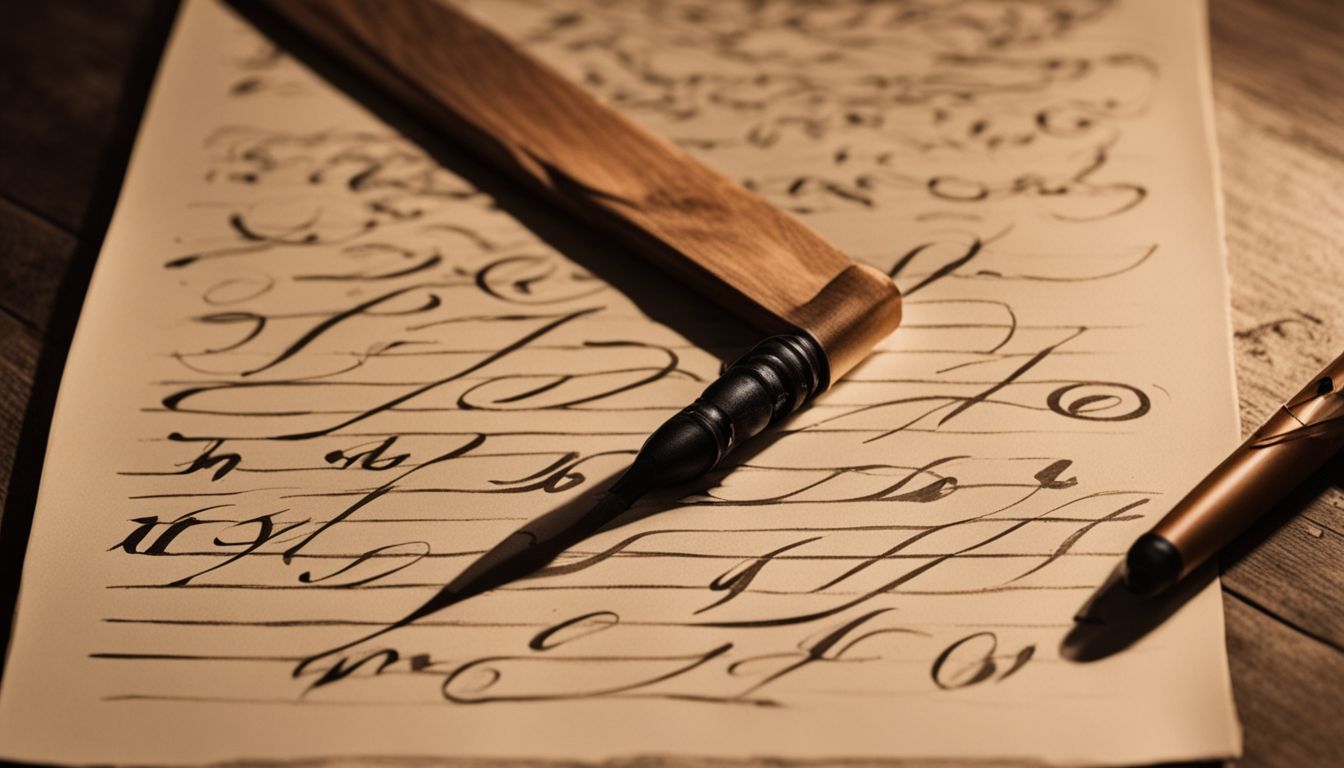Many people find mastering the art of calligraphy lowercase challenging. One key fact to know is that lowercases form the core of hand-lettering elegance. Our blog post offers a guide to perfect your skills in this area, focusing on fundamental strokes and letter formation.
Get ready to transform your writing!
Understanding Basic Strokes in Lowercase Calligraphy

Mastering the art of lowercase calligraphy begins with understanding the basic strokes. It involves learning and perfecting full pressure strokes, under turns and over turns, as well as compound curves or double turns.
These fundamental elements form the foundation for creating beautiful and consistent lowercase letter forms in calligraphy.
Full pressure stroke
Full pressure stroke holds a significant part in contemporary calligraphy, especially while crafting lowercase letters such as p, d, t with extended stems, f, h k, g, j q, and y that are part of the loop stem.
This technique necessitates consistent pressure to create strokes of even width. These strokes mimic a shaded parallelogram at an angle, which is crucial for attaining the refined look associated with copperplate script.
For instance, the standard letter ‘p’ should stand three x-heights tall to sustain uniformity in lettering.
In practice, making sure that the upper stems of letters like p and d reach the first ascender line, while lower stems of letters like f and p touch the first descender line, needs patience and exact control over your pen or nib.
This discipline improves the font quality and aids in a calligrapher’s skill development in creating appealing cursive writing without serifs. Through direct exposure with these techniques, budding calligraphers understand the vital role slight pressure changes play in designing character shapes within their art.
Subsequently, the skill of mastering under turn and over turn movements is developed.
Under turn and over turn
Mastering under turn and over turn strokes plays a vital role in achieving consistency in lettering, especially in modern calligraphy. Under turn letters include ‘i’, ‘u’, ‘w’, ‘a’, ‘d’, with an extended stem, ‘t’, and when connected with a loop stem, the letter ‘b’.
The dot of ‘i’ should have the same weight as the stroke below it. For these characters, the pen moves smoothly to create a curve that dips down before curving up again. This motion lays the foundation for smooth transitions between capital letters and lowercase ones.
Over turns form part of the letters ‘m’, ‘n’, and ‘r’. They demand skillful control since they must be drawn in one fluid movement without lifting the pen at all at the header line.
From my own hands-on experience, practicing these strokes with different pens helps identify which tools suit your style best while working toward right-brained creativity and reason.
It’s fascinating how such simple curves contribute significantly to mastering entire alphabets in various calligraphy styles.
Compound curve / Double turn
Transitioning from the basic under turn and over turn, we next tackle the slightly complex compound curve or double turn. This method is integral for letters like v, x, p, m, n, h, y, k, and r in lowercase calligraphy.
Each of these letters incorporates a succession of three specific strokes: a left curve leading into a shade and ending with a right curve. Refining this motion requires practice but contributes grace to your writing.
From personal experience, mastering these curves at smaller x-heights was initially challenging. The key lies in sustaining consistent pressure throughout each stroke to ensure uniformity across all compound curve letters.
Frequent practice of these movements improves muscle memory and advances your overall calligraphy abilities. Gaining expertise in executing compound curves can notably enhance the quality of lowercase letters, resulting in a more fluid and dynamic appearance.
Letter Group Practices for Consistency
Practice creating consistent letter groups to improve your calligraphy skills. Achieve uniformity in ovals and loops for a polished finished look.
Ovals: Regular and reverse
Regular ovals are found in the letters a, d, o, g, q. Reverse ovals appear in c, e, r, x, s, and z. The direction of reverse ovals is clockwise. Regular ovals feature shading on the right side, while reverse ovals have shading on the left side. Aim for uniform thickness when creating shades on both types of ovals to achieve consistency in your calligraphy work.
Loops: Lower and upper
To ensure your lowercase calligraphy is consistent and visually appealing, it’s essential to master the lower and upper loops of specific letters. Below are the key points to consider when practicing and perfecting these elements:
- Loops play a crucial role in letters such as “f,” “h,” “k,” “b,” and “l.” Understanding the symmetry and width of loops is vital for achieving consistency in your calligraphy.
- The teardrop shape inside loops should be symmetrical, enhancing the overall aesthetic of the letter forms.
- While the width of loops should generally match that of an oval, adjustments can be made according to individual style preferences.
- Pay attention to ‘j,’ ensuring its shade height aligns with ‘g’ and ‘y.’ Consistency in loop shapes is key for a polished finish across various lowercase letters.
By mastering these details, you can elevate the quality of your lowercase calligraphy and achieve greater visual impact in your work while maintaining consistency throughout.
Tools Needed for Lowercase Calligraphy
To start lowercase calligraphy, you need specific tools and materials. Pens and nibs are essential, as well as high-quality paper to elevate your work.
Choosing the right pens and nibs
Selecting the proper pens and nibs is critical for achieving consistent, high-quality lowercase calligraphy. The choice of tools significantly impacts the outcome of your work. When choosing a pen, consider the size and shape of the nib to ensure it aligns with your desired style.
Quality paper is equally important; it enhances ink flow and prevents feathering or bleeding, ultimately elevating the overall result.
Invest time in experimenting with different pen types and nib sizes to find what works best for you. Opt for quality tools as they can make a noticeable difference in your calligraphy work.
Experimenting with various combinations will allow you to uncover which pens and nibs complement your personal writing style effectively.
Importance of quality paper
Quality paper is essential for practicing lowercase calligraphy as it prevents ink bleeding and ensures a smooth writing surface. The Strathmore Sketch Spiral Paper Pad (5.5” x 8.5”) comes highly recommended for its ability to withstand various ink types, maintaining crisp lines and preventing feathering or bleed-through.
Utilizing quality paper enhances the overall experience of practicing lowercase calligraphy, allowing for precise strokes and consistent letterforms.
Moving on to the next section “Exploring Different Styles: An Introduction to Japanese Calligraphy” we will delve into the unique aspects of this captivating art form.
Exploring Different Styles: An Introduction to Japanese Calligraphy
When exploring different styles in the world of calligraphy, an introduction to Japanese calligraphy offers a unique and rich perspective. Also known as Shodo, Japanese calligraphy is deeply rooted in tradition and culture, with a history dating back to the 28th century BCE.
This art form emphasizes the importance of brushstrokes, ink density, and overall balance in creating visually stunning characters. Practitioners of Japanese calligraphy use tools such as brushes made from animal hair or synthetic materials, along with high-quality rice paper known as washi.
The techniques employed are not just about enhancing the visual appeal of each character but also embodying a deeper spiritual and philosophical meaning.
Japanese calligraphy unveils the secrets behind expressive brushwork and powerful composition through its emphasis on minimalism and simplicity. It’s about crafting more than just letters; it’s about seeking a profound form of writing – it’s about embarking on a journey that delves into mindfulness and self-expression.
Practicing this art form allows individuals to delve into a first-hand experience of the intricate details that underpin both traditional and modern approaches towards creating beautiful lettering compositions.
Advanced Techniques and Tips
Master the art of calligraphy with advanced techniques including controlling thick and thin lines, as well as creating unique letter combinations for a personalized touch. Ensure to read more on how these tips can elevate your lowercase calligraphy skills to the next level.
Thick and thin line dynamics
Thick and thin line dynamics play a vital role in mastering lowercase calligraphy. In modern calligraphy, the rule is clear: downstrokes should be heavier, while upstrokes should be lighter.
This approach demands careful pen control to achieve the intended outcome. For instance, in Copperplate, creating a lowercase ‘a’ involves three specific strokes: an entrance line, an oval, and an underturn.
Recognizing this concept is crucial for anyone beginning their journey into the world of lowercase calligraphy. The focus on thick-to-thin strokes not only supports the art but also shapes the creation of individual letters with accuracy and coherence.
Creating lettering combinations and typography lines
Transitioning from understanding thick and thin line dynamics, creating lettering combinations and typography lines involves exploring different pairings of letters to achieve harmonious visual appeal.
For instance, experimenting with the combination of “aa,” “ab,” or “ac” can enhance proficiency in incorporating distinct styles. Paying attention to typography lines, such as capital height, baseline, descender, x-height, and ascender height is crucial for achieving consistency and balance within the composition.
Consistency in starting points across over turns and under turns contributes to a seamless flow of the calligraphy. Regularly pausing between writing letters facilitates an assessment of baseline height to ensure uniformity throughout the script.
This practice reinforces precision while enabling individuals engaged in this art form to create visually captivating results that align with established calligraphy standards.
Conclusion and Practice Recommendations
Mastering lowercase calligraphy demands practicing the basic strokes and focusing on consistency. It’s crucial to experiment with different styles and tools to refine your skills. Keep in mind, the essential elements for success are dedication and patience in perfecting your craft.
FAQs
1. What is the importance of mastering uppercase letters in calligraphy?
Mastering uppercase letters in calligraphy adds style and elegance to your writing. It helps you create striking, balanced compositions.
2. Can I start learning calligraphy with uppercase letters?
Yes, you can begin learning calligraphy with uppercase letters. It may be challenging but it will improve your skills.
3. How do lowercase and uppercase letters differ in calligraphy?
In calligraphy, both lowercase and uppercase letters have unique styles. Uppercase letters often are more ornate and take up more space than their lowercase counterparts.
4. Are there any special techniques for drawing uppercase letters in calligraphy?
Yes, there are special techniques for drawing uppercase letters in calligraphy that involve careful strokes and line placement to ensure each letter’s distinct shape is achieved correctly.




Leave a Reply
You must be logged in to post a comment.